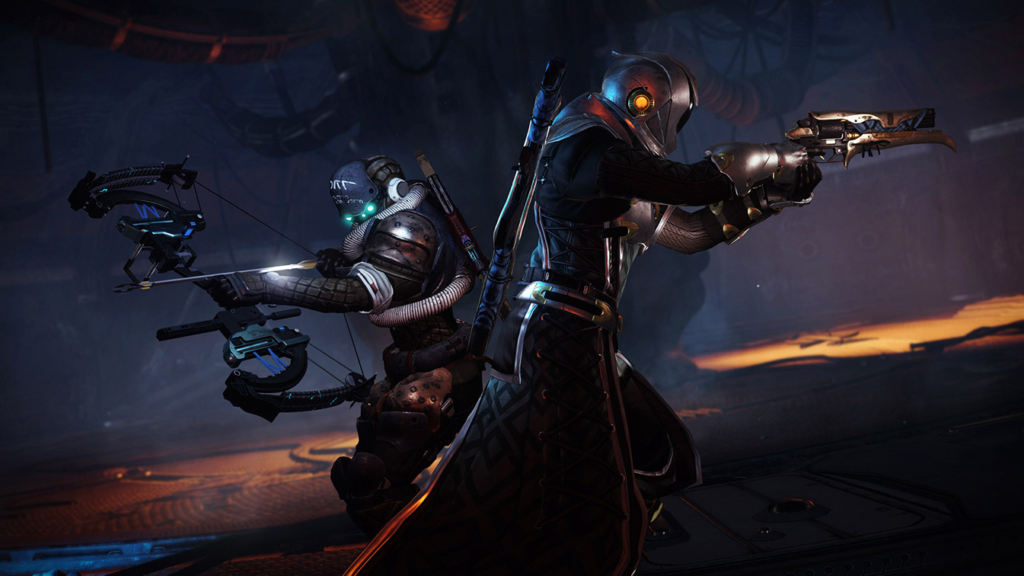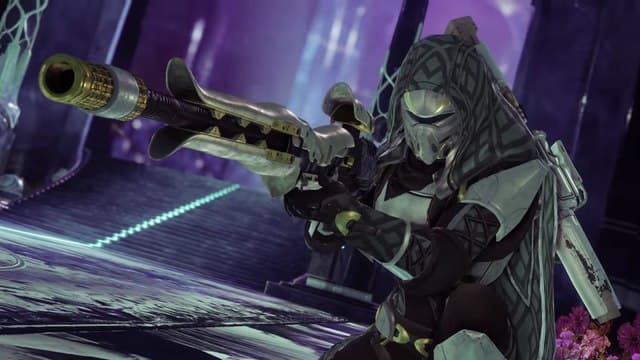Destiny 2: Forsaken is a helluva shot in the arm for a game that needed one. Its similarities to The Taken King, the major expansion that “fixed” the first game, are both obvious and implicit. The villain is a character who disappeared at the start of The Taken King. The plot carries shades of spaghetti western revenge, but eventually picks up the space magic threads left by that older expansion. And of course everyone wants Forsaken to “fix” Destiny 2—myself included.
Destiny 2 took a lot of legends from its predecessor. They just weren’t the ones fans ultimately wanted. The story was comprehensible, for example, (which is more than I can say for the first game) but… also kind of dull. The dreamlike intrigue of Destiny’s background lore was nowhere to be found.
The weapons, such a key part of what hooked players on the first game, were balanced into oblivion. My wacky arsenal no longer felt unique or powerful. Sure, that meant I couldn’t run roughshod over the Crucible: Destiny’s PVP arena. It also made acquiring new gear less exciting.
Without those—the guttural excitement over new loot and that feverish sense of mystery—I fell of Destiny 2. Hard. I had my fun with the campaign, and returned for each so-so expansion, but was content to move on. Others weren’t so satisfied with just stopping, whether they had a regular drip of new stuff to play or not. Forsaken feels custom-made to slow down that quick turnaround.
The expansion sports two all-new regions: the Tangled Shore and the Dreaming City. The shore, actually a loosely tangled asteroid belt ruled by a smuggler called the Spider, is where most of the new campaign occurs. You’re hunting Prince Uldren. The royal pain kicks off the expansion by murdering Destiny’s divisive, wisecracking sidekick Cayde-6. Players hunt him and his accomplices across a set of missions that are much more open than in previous updates.
That’s because you can technically tackle the quests in any order. Each comes with a level recommendation slightly higher than the last. But you could theoretically power up in side activities to squash each one-note villain at your own pace.
And despite being one-note (one baddie loves motorcycles, another uses bombs, a third is a sort of wizard, etc.) the missions themselves are some of the most diverse activities in Destiny 2. One is an extended chase sequence, where you battle from room to room entirely on hover-bikes. Another pits you against a sniper hidden among a dozen hologram copies of himself. For once, no two missions in a Destiny expansion feel quite the same.

That’s before you even get to the Dreaming City. The late-game zone didn’t unlock until I beat the main campaign. When it did, though, I was treated to misty cliff-sides and sparkling citadels unlike anything else in the series. The zone is a homestead of the Awoken—Destiny’s glowing space elves—and home to all sorts of little secrets to uncover. It’s like a larger, less disgusting version of the The Taken King’s Dreadnaught that way. Although the Dreaming Cities’ mysteries are more structured, more repeatable, than that expansion’s.
My personal favorite so far are the “Ascendant Challenges.” These weekly side quests ask you to get high on space drugs to open alien portals. Once you find the portal, there’s a new mini-mission to complete in yet another unique environment. Destiny’s art has always been one of its strong suits. Forsaken leans all the way into this with its sheer volume of otherworldly locales, while including plenty of things to actually do in them.
That meticulous structure does suck out a bit of the magic, though. In The Taken King, I once found a timed platforming challenge while hiding in a cave from enemy fire. In Forsaken, I learned about Ascendant Challenges because an NPC gave me a bounty to find one. The expansion has jacked up the level cap considerably and nearly everything you do in Destiny 2, even the hidden little activities, contributes to it.
Which is fine. The sense of constant progress is a great step up from the base game—especially now that developer Bungie has buffed the game’s gear to be less “balanced” again. New exotic equipment opens up entire new play styles again. Although exotics are so rare now that it doesn’t happen often.
That might be a divisive change. On the one hand, it supports Forsaken’s longer tail. You need to grind for more gear, to reach higher levels, but have so many more opportunities to earn it week-by-week. I think the new exotic drop rate makes those special pieces feel that much more… special, but it exacerbates the old frustration of not getting the one you want.
Speaking of old frustrations, Forsaken still has a few.

Besides the new zones and a new raid, the expansion’s flashiest selling point is Gambit. The “PVE/PVP” mode puts two teams of four in a race to kill normal enemies. Killing enough enemies, and banking the tokens they leave behind, summons a boss. Whichever team beats that boss first is declared winner.
The mode is a blast—probably the most fun I’ve had in competitive Destiny 2. I get the same competitive tension from the Crucible without constantly being removed from play due to shotgun blasts to the back. It’s nearly as pulse-pounding as directly combating other humans. It’s just not as frustrating. No. My problem isn’t with Gambit itself. It’s with the Forsaken quest tied to the mode.
See, one player from either team in Gambit can periodically invade the other to fight them directly. And the quest “Cayde’s Will,” likely the first new exotic quest players will encounter, is tied to killing those suped-up invaders with a specific weapon. It’s a very old school style of Destiny quest—one that requires you to use a weapon you might not like, to compete against your own allies, in the hopes that you’re better than another human player, instead of actually focusing on your objective. It’s not the worst such quest in Destiny history, but it stands out because it’s so front-and-center (you get the quest for completing the story).
More than that, Cayde’s Will makes me worry. It’s Destiny 2 design at its worst, when I’m meant to believe the game has finally reached its peak. We’ve danced this dance before. The Taken King was supposed to show that Bungie learned from its mistakes a year after release. Yet here we are, a year after Destiny 2’s launch, hearing the same spiel. You can’t draw so many narrative and marketing connections to that earlier expansion without also reminding me of the cycle we just repeated. Any mistakes in Forsaken, the developer’s fourth real chance to get it right, stand out more clearly than ever.
So it’s a good thing the expansion is generally fantastic. The weapons feel better. The new regions are more vivid. The grind is longer, but offers much more variety, and the new activities in the mix are some of the best we’ve ever seen. The complains I have are only so worrisome because of the series’ track record. That doesn’t change how good Destiny 2: Forsaken is right now, however. If you’re ready for more space magic with a western twist, now’s the best time to jump back in… again.

